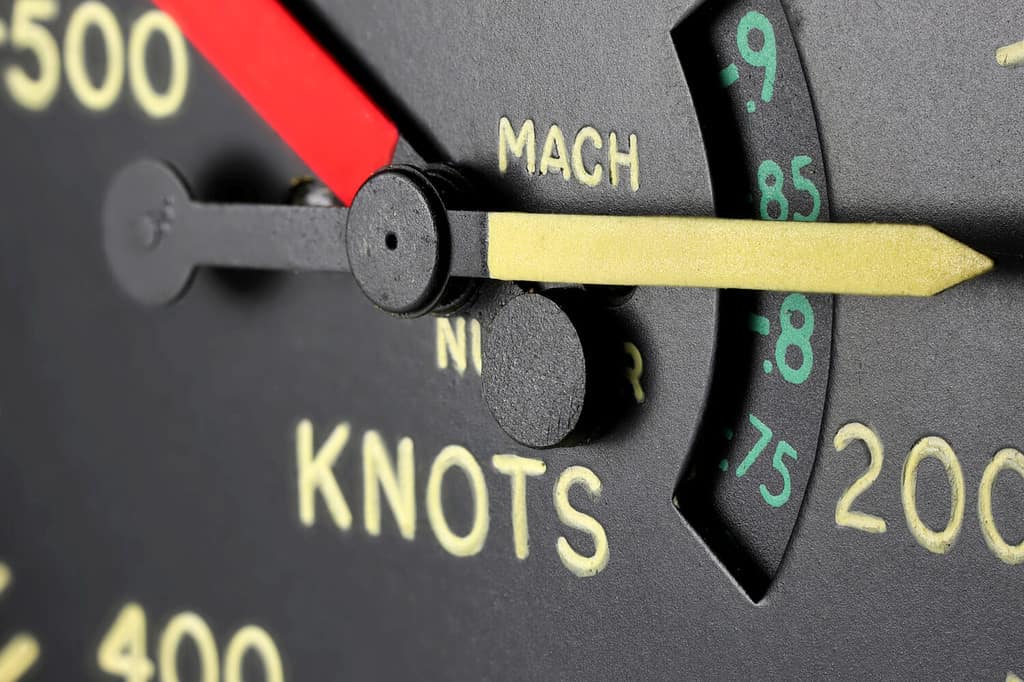On October 14, 1947, U.S. Air Force Captain Charles E. Yeager piloted the first aircraft to break the sound barrier, the Bell X-1. But that was just Mach 1. Mach 10 is ten times faster, almost unimaginably speedy. So just how fast is Mach 10? Have we reached it yet? And what’s a Mach number, anyway?
What Is the Mach Number?
The Mach number is the ratio of the speed of a given object to the local speed of sound. The speed of sound depends on a number of environmental factors like air temperature, air density, and other atmospheric conditions. Mach 1 is equal to the speed of sound, which is approximately 767 miles per hour on a typical day at sea level with a temperature of 68°F (20°C).
Here are a few helpful terms scientists use to describe various Mach numbers:
- Subsonic: Mach is less than 0.8 (Mach < the speed of sound)
- Transonic: Mach is nearly equal to 1 (Mach ~ the speed of sound)
- Sonic: Mach is equal to 1 (Mach = the speed of sound)
- Supersonic: Mach is greater than 1 (Mach > the speed of sound)
- Hypersonic: Mach is greater than 5 (Mach > 5 times the speed of sound)
- High-Hypersonic: Mach is between 10 and 25 (Mach > 10 times the speed of sound)
How Fast Is Mach 10?

Mach 10 is approximately 7,672 miles per hour.
©Bjoern Wylezich/Shutterstock.com
Mach 10 is approximately 7,672 miles per hour (2.13 miles per second). This is equivalent to 12,347 kilometers per hour, 11,252 feet per second, or 3,430 meters per second. Expressed another way, Mach 10 is 10 times the speed of sound. Remember that these are approximate values dependent on local atmospheric conditions.
Speeds of Objects Compared to Mach 10
Not many objects travel at speeds comparable to Mach 10 (7,672 mph). To get an idea of just how fast this is, take a look at this table of some of the fastest objects in the world:
| Object | Speed |
|---|---|
| Fastest car in the world (Koenigsegg Jesko Absolut) | 330 mph (484 ft/s or 148 m/s) |
| A bullet from the fastest commercial cartridge in the world (.220 Swift rifle) | 3,180 mph (4,465 ft/s or 1,422 m/s) |
| Fastest aircraft in the world (North American X-15) | 4,520 mph (6,629 ft/s or 2,021 m/s) |
| Average space shuttle (orbital speed) | 17,500 mph (25,667 ft/s or 7,823 m/s) |
| Fastest spacecraft in the world (Parker Solar Probe) | 364,660 mph (534,835 ft/s or 163,018 m/s) |
| Light | 670,616,629 mph (983,571,056 ft/s or 299,792,458 m/s) |

The fastest aircraft in the world is the North American X-15, which reaches 4,520 mph.
©agsaz/Shutterstock.com
What Is a Sonic Boom?
A sonic boom is the sound of a shock wave caused by an object when it surpasses the speed of sound. Scientists also refer to this as “breaking the sound barrier.” The sound (or sonic) barrier refers to the dramatic increase in aerodynamic drag that objects experience when approaching the speed of sound. This drag forms an invisible “barrier” that is difficult to break through.
Many people have experienced the unsettling sound and tremors of a sonic boom from military aircraft passing overhead. On April 27, 1973, the United States government passed a law prohibiting civilian aircraft from breaking the sound barrier. This was meant to avoid startling people living below. However, NASA is currently working on the X-59, a quieter version of traditional supersonic aircraft. If successful, the project could potentially render the law obsolete and pave the way for supersonic overland travel.
How to Calculate the Mach Number
The formula for calculating the Mach number is very simple:
M = u/c
Where:
- M = Mach number
- u = local flow velocity (speed of the object)
- c = speed of sound in the medium
Both u and c should be expressed in the same units of velocity. In other words, if you express the speed of the given object in miles per hour, you should also use miles per hour to express the speed of sound.
Why Is It Called “Mach”?
The Mach number gets its name from Austrian physicist and philosopher Ernst Mach (February 18, 1838 – February 19, 1916). Among other things, Mach contributed to the study of shock waves and gas dynamics. However, it was Swiss aeronautical engineer Jakob Ackeret (March 17, 1898 – March 27, 1981) who suggested calling the Mach number by Ernst Mach’s name.
When Should You Use Mach to Refer to Speed?

The Mach number is most useful for measuring the speed of aircraft and space shuttles.
The Mach number is not very useful for most people in the majority of day-to-day applications. The fastest objects in ordinary use are typically cars, most of which are incapable of exceeding 300 miles per hour (well below the speed of sound). There are only a few exceptions to this. For this reason, scientists mostly use the Mach number for aviation purposes.
Summary Table of Mach Numbers (Mach 1-10)
Below is a summary table of Mach numbers and their speeds from Mach 1 to Mach 10. Keep in mind that these are only approximate values as the speed of sound varies slightly due to atmospheric conditions.
| Mach Number | Approximate Speed in Miles Per Hour |
|---|---|
| Mach 1 | 767 mph |
| Mach 2 | 1,534 mph |
| Mach 3 | 2,301 mph |
| Mach 4 | 3,069 mph |
| Mach 5 | 3,836 mph |
| Mach 6 | 4,603 mph |
| Mach 7 | 5,370 mph |
| Mach 8 | 6,138 mph |
| Mach 9 | 6,905 mph |
| Mach 10 | 7,672 mph |
The photo featured at the top of this post is © Marc Ward/Shutterstock.com
Thank you for reading! Have some feedback for us? Contact the AZ Animals editorial team.







